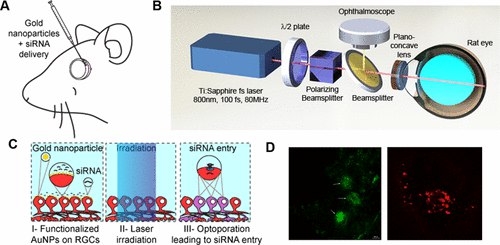Eye piercing with laser and gold nanoparticles
Subject: science and research: #laser #retinal #gold_nanoparticles #eyes
News date: 09/18/2017
https://pubs.acs.org/appl/literatum/publisher/achs/journals/content/nalefd/2018/nalefd.2018.18.issue-11/acs.nanolett.8b02896/20181108/images/medium/nl-2018- 02896g_0005.gif
Canadian researchers managed to create a nanometer hole on the surface of the retina by laser radiation; Gold nanoparticles have been used for this purpose. This method allows the introduction of medicine into the eye through these holes.
Canadian researchers’ findings show that gold nanoparticles can be used to treat eye problems. The group used gold nanoparticles as nanolenses to focus femtosecond pulsed laser beams onto the surface of retinal cells. With this technology, a special drug or gene can be introduced into the eye, and researchers hope to be able to use it to treat diseases such as cataracts.
In 2009, Michael Monier of the Polytechnic University of Montreal found that pulsed laser radiation can create nanoscale holes on the surface of silicon, provided that the surface is coated with gold nanoparticles. He and his colleagues investigated this phenomenon to see if it could be done in living cells.
Finally, their studies showed that a laser with a wavelength of 800 nm can be absorbed by cells and pierce it. They went a step further and tried to do this in living cells, such as eye cells.
The researchers succeeded in doing so and found that the technology could be used to pierce a variety of living surfaces. This group irradiated a pulsed laser on the living cells of the retina and created a hole on it. This hole allows the transfer of medicine or genetic material into the eye.
If functionalized gold nanoparticles are used, special and predetermined cells can be placed on the target surface and drilling can be done with high precision.
According to the interesting results of this group, they are registering a patent related to this technology in America. The results of this project have been published in the form of an article titled In Vivo Laser-Mediated Retinal Ganglion Cell Optoporation Using KV1.1 Conjugated Gold Nanoparticles in the journal Nano Letters.
Source:
https://pubs.acs.org/doi/10.1021/acs.nanolett.8b02896
.
Nanobiotechnology Laboratory:
https://t.me/NanobiotechLab
.
Contact us:
@NanoBioLab
.
This post is written by NanoBioLab
